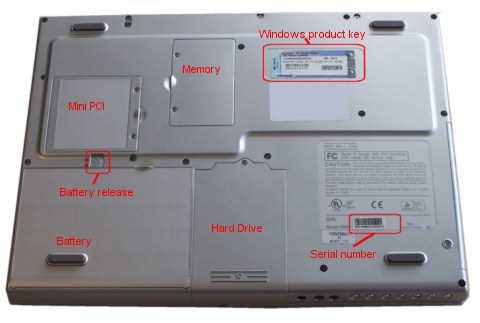 Acer File Extensions |
Advent 7019 Laptop
Specification
| CPU | Intel Pentium 4-M 2.20 GHz |
| BIOS | Insyde BIOS. Press the F2 key to enter. |
| Memory | 512MB PC2100 DDR SODIMM (2 memory slots. Max 1GB) |
| Hard Drive | 80GB Toshiba MK8025GAS |
| CD Drive | Toshiba DVD-RW SD-R6112 |
| Screen | 15.2" widescreen TFT (native resolution 1280x854) |
| Video Card | nVIDIA GeForce 4 440 GO (64 MB) |
| Sound Card | Realtek AC'97 audio |
| Modem | 56k |
| Network Card | Realtek 8139 / 810X (onboard) Intersil Prism wireless LAN PCI card |
| PC Card | 1x Type I/II |
| Ports | 1x PC card slot 1x IR 2x USB 2.0 1x IEEE1394 (FireWire) 1x LAN 1x Parallel 1x VGA 1x S-Video (TV-Out) 1x Kensington Lock 1x Modem 1x Microphone 1x Line-in 1x Headphone |
| Weight | 3.0kg |
| Made by | Hi Grade 8060 Mitac 8060 |
Drivers
Your laptop should have a backup copy of all the drivers, you can find it by browsing to the c:\applications\drivers folder.
Bottom of Laptop

Function Keys
Fn + F1 - Turns wireless communications on and off
Fn + F5 - Switches between internal and external displays
Fn + F6 - Decreases brightness
Fn + F7 - Increases brightness
Fn + F10 - Turns the low battery warning on or off
Fn + F11 - Switches the LCD panel on and off
Fn + F12 - Place the computer into hibernate mode
Fn + Ins - Num lock
Fn + Del - Scroll lock
In the Box
Disks Supplied
- Advent system recovery CD version 2.1
- Advent 7019 update CD
- PowerDVD XP 4.0 (CD key printed on the CD sleeve)
- Nero Burning ROM 5 CD
- Microsoft Works Suite 2002 ( 5 CDs, product key on CD box)
Items Supplied
- Advent 7019 notebook
- Mains power adapter
- Mains power cable
- UK modem cable
- BT phone connector
Documentation Supplied
- Advent notebook installation manual and troubleshooting guide
- User manual
- Microsoft Windows XP Home Edition "Start here" guide
- Freeserve leaflet
Recovery Disc
Due to the nature of the recovery process you should not use FDISK or any other partition management software to delete the partition on your Advent computer. Doing so will prevent the recovery from functioning correctly. If the recovery asks for a second CD you will need to obtain an Update CD from Advent.
To recover your Advent PC you will need your Advent System Recovery CD.
- Place the CD into the DVD drive and restart your computer.
- Press R on the keyboard when prompted.
- The recovery will load and display a menu of options:
- Non-destructive recovery: This option will restore Windows, supplied applications, and drivers. This option will not destroy your documents or programs. These will be backed up along with the registry. These are restored at the end of the recovery process.
- System Recovery - No format: This will reinstall Windows, supplied applications and drivers. It will move your files to a folder called "My old disk structure". Any applications (except those supplied) will need to be reinstalled.
- System Recovery - Quick format: This option will erase your hard drive including your personal files. Windows, supplied applications and drivers will be reinstalled.
- Select the Non-destructive recovery option and press Next.
- You will be informed about System Restore in Windows, click Yes.
- The recovery will begin. Once this is complete you should eject the CD and click Restart.
Additional information.
Press the ALT and D keys at the recovery menu to access a command prompt. This will allow access to C: drive. The command prompt will default to E:\i386\system32 where you can run a variety of tools including CHKDSK.EXE.
Reinstalling applications
From version 2.x of the recovery system onwards you can install applications from the c:\applications folder. Drivers can be installed from the c:\applications\drivers folder and utilities from the c:\applications\tools folder. You will still need to install Microsoft Works from the supplied CD.
FAQ
Realtek 8139 Network Card Not Connecting
Some machines fitted with a network card based on the Realtek 8139 chip will fail to send and receive data correctly. This can happen if the autodetect feature of the card is not detecting the connection properly. To get round this the connection speed of the card must be set manually
- Right-click upon the My Computer icon and select Properties.
- Select the Hardware tab and click on the Device Manager button.
- Click on the + next to Network Adapters.
- Select the entry for Realtek 8139 from the list and double click upon it.
- Select the Advanced tab.
- Select the entry for Link Speed / Duplex Mode.
- Change the Value setting from Auto to one that is appropriate for the connection (often 100 Full for a connection directly to another PC and 10 Full for a broadband connection).